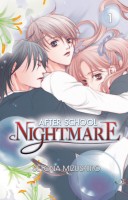 Creator: Setona Mizushiro
Creator: Setona Mizushiro
U.S. publisher: Go! Comi
ISBN: 9781933617169
Released: September 2006
Original release: 2004
After School Nightmare is a ten-volume manga series by Setona Mizushiro. I first came across the series while working my way through one of my local library’s manga collection which, at the time, was largely shelved alphabetically by title. So, it didn’t take me too long to encounter After School Nightmare. I borrowed and read the first few volumes and on the strength of those alone decided to track down and purchase the entire series which had sadly gone out of print. The manga’s dark, horror-tinged psychological drama and its themes exploring gender and sexuality immediately appealed to me; the series had the potential to be both disconcerting and compelling. After School Nightmare, Volume 1 was originally published in Japan in 2004. The English-language edition of the volume was released in 2006 by the now defunct Go! Comi. After School Nightmare has generally been critically well-received in English, even earning an Eisner Award nomination for Best U.S. Edition of International Material among other honors.
Mashiro Ichijo is an androgynously attractive and well-liked you man, but he’s hiding a secret from his classmates—his body is neither entirely male nor entirely female. This has brought Mashiro some challenges in his life and as a result of his physical condition he struggles with his personal identity and gender. Just how much he struggles is made abundantly clear when Mashiro is requested to join a special after-school class which must be completed in order for him to graduate. In it the students must literally live out their nightmares where they are forced to face their darkest fears and bear witness to one another’s deepest secrets. What’s more is that they aren’t there to offer comfort or support. Instead, circumstances encourage them to strike out against their fellow classmates. And even though what happens in the nightmares isn’t to carry over into the real world, sharing such an intimate experience can’t help but change the young people and how they see one another.
The circumstances surrounding the after-school classes are peculiar. Only the students invited to attend seem to be aware of it. The stairs leading down to the infirmary where the class is held in a basement that shouldn’t exist disappears and reappears depending on the day. The teacher in charge isn’t known by the school’s other faculty. Students who “graduate” quietly go missing and are forgotten. All of these things and more add to the foreboding atmosphere of After School Nightmare and the feeling that something just isn’t quite right about what is going on. The shared nightmares themselves are also ominously disconcerting. The imagery is frightening—a girl whose face and heart are gaping holes, disembodied hands and arms, a cruel knight in black armor—but in the end the students’ psychological torment and distress may be even more troubling and gut-wrenching. The nightmares simply reveal the darkness and confusion that they already carry within themselves.
In the dreams, the students take on their true forms, representative of the issues, abuse, and trauma that they are dealing with. Many of them appear so distorted in the nightmares that its difficult to know their identities in the waking world. That’s not the case for Mashiro who looks exactly the same except that, to his horror, he sometimes is wearing the girls’ skirted school uniform in the dreams. This makes him easily identifiable and a target in the real world. He catches the attention of Kureha Fujishima, a young woman who is afraid of men but feels comfortable around Mashiro after learning his secret. And then there’s Sou Mizuhashi who has a reputation for being a playboy and womanizer but who also seems to have taken an intense interest in Mashiro. Though somewhat conflicted over these developments in his relationships with his classmates, Mashiro largely welcomes the attention from Kureha and is understandably uncomfortable with Sou’s aggressive advances towards him. As the first volume of After School Nightmare shows, reality can be just as terrifying if not more so than any nightmare.
